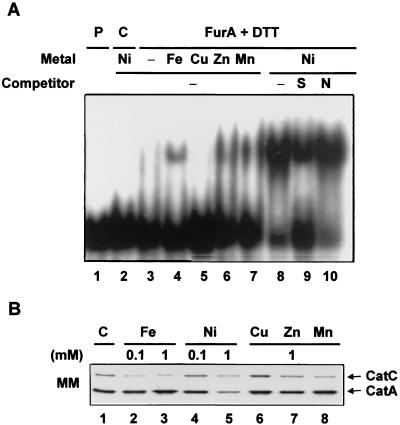FIG. 8.
Effects of various metals on FurA binding in vitro and CatC production in vivo. (A) A gel mobility shift assay was carried out with the D2 fragment of the furA promoter and FurA protein, which was preincubated with 100 mM DTT as described in the legend to Fig. 7. A 100 μM concentration each of NiCl2, FeSO4, CuSO4, ZnCl2, and MnCl2 was added in the binding reaction (lanes 4 to 10). In order to demonstrate the specificity of binding, a 350-fold molar excess of unlabeled D2 fragment (S, lane 9) or HpaII-digested pGEM-3Zf(+) DNA (N, lane 10) was added as a specific or nonspecific competitor, respectively. As a control, a cell extract was prepared from E. coli containing the parental pET3a vector by the same method used to prepare the FurA protein, and the gel mobility shift assay was performed in the presence of DTT and Ni2+ (lane 3). Lane 1 contains only the labeled probe. (B) Effects of various metals on the production of CatC on surface culture. M145 cells were grown on minimal medium plates (MM) containing the above metals at the indicated concentrations. Cells were grown at 30°C for 40 h, and the amounts of CatA and CatC proteins were detected by Western blotting.

